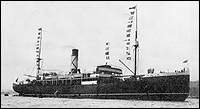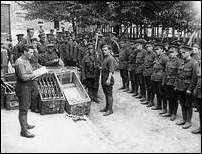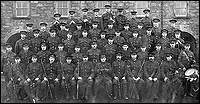|


|

|

Britain
On October 4, 1914, an insufficiently trained and poorly equipped Newfoundland Regiment
set sail on the SS Florizel for further training on England’s Salisbury Plain.
This was the first of some 27 groups to embark from Newfoundland’s shores
during the course of the war.
First Five Hundred on board the S.S. Florizel, at anchor in St. John’s, October 4, 1914.
Courtesy of the Provincial Archives of Newfoundland and Labrador (PANL NA-1249), St. John’s,
Newfoundland.
 (24 Kb)
(24 Kb)
|
 |

|
Being mistaken for Canadians often irritated the Newfoundlanders in England. In a
letter home in December 1914, Private Frank ‘Mayo’ Lind commented that the English “did
not seem to know that Newfoundland is not Canada, but they thoroughly understand now
that Newfoundland is NOT Canada and that we are Newfoundlanders, NOT Canadians”
(Lind 23). Lieutenant Owen Steele further remarked that Newfoundlanders were “very
particular that [they] not be classed as Canadians . . .” and that they were “
much prouder of [their] distinction as Newfoundlanders” (Steele, “Letter to Parents, December 2, 1914”).
Concerns about mistaken identity marked an underlying fear of loss of separate status
for the regiment, that it might be merged with another colonial regiment. Such fears were
heightened during training in Britain when the imperial commanders suggested that they join
a Nova Scotia battalion. This would have cost the regiment its status as an independent
fighting group. Captain J. E. J. Fox later recalled that, “there was the fear that our identity
would be lost with some Canadian unit . . . we felt, quite properly, that if we were to give our
best, we could only do so by preserving our own individuality” (Fox 69–70).

|
 |
Newfoundland Regiment soldiers receive rifles, n.d.
Courtesy of the Provincial Archives of Newfoundland and Labrador, St. John’s, Newfoundland.
 (33 Kb)
(33 Kb)
|
No. 3 Platoon, A Company, Fort George, Scotland, ca. 1915.
Lt. R. H. Tait possibly in
centre of the front row.
Courtesy of the Provincial Archives of Newfoundland and Labrador (PANL B-3-18), St. John’s,
Newfoundland.
 (45 Kb)
(45 Kb)
|
 |

|
This was resolved when, in December 1914, the regiment was sent to Fort George at
Inverness, Scotland, and the Canadians were sent elsewhere. The regiment moved the next spring at Stobs Camp,
at Hawick, southwest of Edinburgh. In August 1915, four companies moved to Aldershot before going overseas.
The remaining companies moved to Ayr, which was to be the regimental depot for most of the war.

|

|
 |